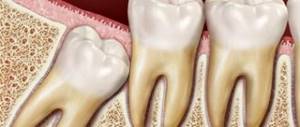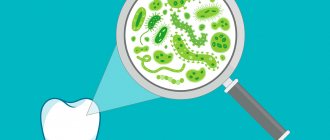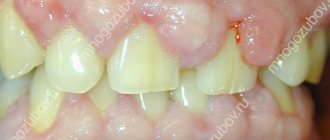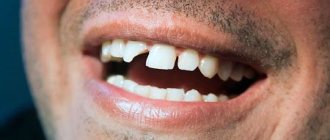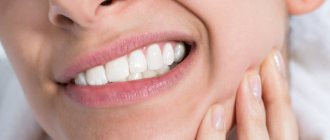01.12.2019
My child’s teeth have started to grow crooked, what should I do? How to solve the problem with milk and permanent curved row. Modern corrective orthodontic systems.
If a child’s tooth grows crookedly, then this is not only a cosmetic problem. A malocclusion can affect the health of the oral cavity and the digestive system. Bite correction must begin at an early age. At the same time, baby and permanent teeth need to be treated for curvature.
A child’s first teeth – and already crooked? Why
When a baby’s first teeth are crooked, parents don’t know what to do, whether it’s dangerous or not. Only a pediatric dentist can answer this question. After the examination, he will advise what measures need to be taken. In any case, you should not panic; it is recommended to pay attention to the following factors:
- if there are even spaces between the teeth, then it is possible to naturally correct the position of the growing units
- unequal gaps indicate shifts in tooth spacing and can lead to deformation of the permanent row
- Do not hope that after crooked baby teeth fall out, the permanent ones will be straight, this may not happen
The reasons for the formation of curvature of the first teeth are the lack of solid food, training of the chewing reflex, diseases of the nasopharynx, heredity, and incorrect anatomy of the frenulum.
Attention! Feeding from a bottle with a soft nipple often causes curvature of the milk line, which then affects the permanent one.
Are your new teeth growing crooked? A few words about braces
If, after falling out, new teeth grow crookedly, then the cause may be late loss of milk teeth. In addition, the uneven eruption of the molar units plays a role, and also that the jaw in its formation lags behind the eruption of large elements. In this case, new teeth can grow not only crooked, but also in two rows. If the curvature is temporary, then the appearance of a double row requires the intervention of an orthodontist. Currently, there is an effective system for correcting malocclusion and curvature - braces. They are attached to the enamel coating and work according to a tension system of various structural elements. This alignment of the teeth is a long process and inconvenient for the baby, since braces cannot be removed during the treatment period. There are two types of braces - those attached to the outside of the row and to the inside. The first are called vestibular, the second - lingual. But the latter complicate the chewing process, so they are rarely used for children.
Recommendation No. 4. Be sure to visit a pediatric orthodontist
The most important thing to do if your child has crooked teeth is to see an orthodontist. The specialist will diagnose and prescribe treatment. However, it is not at all necessary to contact this doctor only when you are faced with a problem. It is recommended to visit him even if there are no obvious abnormalities in the baby. The best age is 2–3 years, when the formation of the primary bite is completed, or 6–8 years, when the permanent bite begins to form.
It is worth visiting an orthodontist from early childhood
“My son’s lower and upper teeth don’t seem to grow crooked, but by the age of six, terrible gaps appeared between the upper ones. I immediately panicked and went to the dentist. It turned out that this is normal and even good, because... The jaw has begun to grow and expand, creating additional space for the eruption of large molars and permanent teeth!”
Lada, review from woman.ru
Is it possible to completely correct crooked teeth?
Having discovered a problem, parents wonder whether it is possible to correct crooked teeth and how to do this so that the baby does not experience discomfort. Alignment is easier for children than for adults.
- Gum tissues are pliable and perfectly susceptible to orthopedic influences.
- Dental units are plastic, so they easily fall into place
- Children's bites can be corrected without the use of radical methods.
Keep in mind! Complete correction of the dentition in childhood is possible; this must be done before the age of 8 years. Timely correction will help avoid orthodontic problems in the future.
What could be the consequences?
The consequences of ignoring the curvature of the dentition can be very disastrous:
- In crowded areas, favorable conditions arise for the development of pathogenic microflora. This factor contributes to the occurrence of inflammatory diseases .
- As a result of increased pressure on certain teeth, atrophy of some areas of the periodontium . This causes periodontal disease and greatly weakens the dentition.
- Decline in the functionality of the dentofacial apparatus . Insufficiently chewed food entering the stomach causes gastrointestinal diseases.
To avoid such problems, it is worth engaging in prevention and preventing curvature.
What to do if your child’s teeth begin to grow crookedly
When a child has crooked teeth, parents will learn from a doctor’s consultation what to do and how not to be late with straightening. The step-by-step actions look like this:
- monitor your baby’s oral cavity and pay attention to how the baby teeth change position
- pays attention to nutrition, introduce calcium, vitamins, microelements into the diet
- start feeding solid foods on time from 8 months of age
- treat chronic diseases of the nasopharynx, eliminate problems when the baby breathes through the mouth
- make efforts to eliminate the habit of sucking a pacifier, finger, constantly sleeping with a bottle
By eliminating the causes and being vigilant and not postponing a visit to the pediatric dentist, you can solve the problem in a timely manner.
Tips for parents on prevention
1. Wean your child off pacifiers in a timely manner (from about 8 to 9 months, since it is during this period that the baby develops a chewing reflex and the need for sucking decreases) or replace them with anatomically shaped vestibular plates.
2. Fight your child’s bad habits. Wean him off, for example, thumb sucking or nail biting.
3. Monitor your child’s diet, including more solid fresh vegetables and fruits in his diet - carrots, apples, pears, cucumbers and the like.
4. Monitor the health of teeth (including milk teeth) and gums by forcing your child to maintain oral hygiene. Visit the dentist with your child at least twice a year: treat caries and other dental diseases and try to prevent the loss of baby teeth too early - this can lead to displacement of the entire dentition. If premature removal of a baby tooth is unavoidable, doctors advise replacing it with a removable denture.
Fighting crooked baby teeth in a child
A child's crooked baby teeth can straighten naturally. In infants, bone jaw structures are formed, gum tissue grows, and teeth erupt. These processes are accompanied by some deformations, which dentists consider to be transient. That is, as all the units in the row appear, each of them finds its place, grinds in and is leveled. But if uneven gaps appear between the teeth, noticeable even to you, then urgent measures need to be taken. This sign is evidence of asymmetry in the development of the jaws. The consequences of curvature of the mammary row are unpleasant for the baby:
- a crooked tooth causes injury to the oral cavity, causing stomatitis
- poor chewing of food, affecting the functioning of the gastrointestinal tract
- there is pain in the jaw joint
- Difficulties in brushing contribute to the formation of oral infections and caries
That is, you need to fight the problem, but to do this you need to use the methods recommended by the doctor. For example, an effective system for correcting primary teeth is the use of soft vestibular plates that guide the growth of units and eliminate the defect at a very early stage.
Causes of curvature over time
With age, the human body undergoes significant changes. Teeth become loose and shift - they are influenced by forces both within and outside a person’s control. The main ones are the movements of the tongue, lips, and jaws.
One of the most serious causes of displacement is forceful tongue thrusting. It occurs during swallowing.
The teeth are constantly pressing against each other. When the jaw closes, they assume a state of rest. If one of them is missing, the neighboring ones, as well as the opposite one, begin to shift towards the opened space.
With age, the enamel gradually wears away. As a result, they become thinner and weaker. The bottom row grinds down especially quickly. When it cannot withstand the pressure of the top row, it begins to develop crookedly.
Bruxism - jaw grinding during sleep - also contributes significantly to the displacement , severely curving the upper row.
Caries promotes the formation of gaps between teeth, which fill adjacent ones, which contributes to their curvature.
How to correct crooked permanent teeth in a child
When children have crooked permanent teeth, the problem becomes much more complicated. The new units that have grown to replace dairy ones are larger. They need more space, the jaw develops more slowly, so the tooth becomes crooked and remains that way in the formed row. Permanent units have more powerful roots and are difficult to force to change position.
Correcting curvature with braces should begin in middle school. You will have to wear them for about 20 months. By adolescence, the dentition will already become normal, the child will not be embarrassed. It is advisable to use transparent lingual braces. They are attached to the inside and are invisible to other people.
Recommendation No. 6. Select an orthodontic appliance with your doctor
What will the doctor do if he discovers crooked teeth in a child? In accordance with the age of the young patient and the clinical situation, the specialist will select the most effective orthodontic device that will help correct the pathology. Today, correction of anomalies can be carried out even in small children who are 2–3 years old. As a rule, these patients are prescribed orthodontic nipples, as well as massage.
All orthodontic devices for treatment are divided into removable and non-removable.
Removable devices
- trainers and LM-activators, elastic positioners: myofunctional structures that are suitable for those who are already 5–8 years old. They can be used to prevent dental anomalies and to straighten crooked teeth. They also simultaneously eliminate bad habits, form muscle memory, help position the tongue correctly and develop the correct type of breathing,
This is what trainers look like - plates: they can be removable or non-removable. Used to expand the jaw, combined with screws and springs. There are options for children 2–5 years old, as well as for those aged 6–13 years old,
The photo shows a dental plate - aligners: previously only adults were treated with them, but progress does not stand still. Today, these transparent silicone mouthguards are also used for children who have reached the age of at least 6 years. True, only a limited number of manufacturers produce these for young patients, for example, Invisalign. There are series for children and teenagers. Such designs are more expensive than those listed above, but they are distinguished by high aesthetics and level of comfort.
You can straighten your teeth with aligners
Removable systems are convenient because they can be removed from the mouth to eat or brush your teeth. You can also divide the operating time into convenient and comfortable intervals for the child (for example, half an hour while watching cartoons). They are easy to get used to. The main time of treatment is at night, that is, the structures should be in the mouth during sleep. Along with wearing the devices, a course of myogymnastic exercises can be prescribed.
If a child is prescribed removable devices, then the lion's share of responsibility for the treatment process falls on his parents. In order for there to be a result, adults need to constantly monitor the child and take into account the time when the structure should be in the oral cavity. While wearing it, you cannot open your mouth, speak or laugh.
Fixed devices
What to do if a teenager has crooked teeth? Those who are already 12–14 years old are mainly prescribed treatment with braces. These are non-removable devices that take some getting used to. For children, it is recommended to choose inexpensive structures made of metal, plastic, as well as colored braces with ligatures (elastic bands that secure the arch in the grooves and can be of different colors).
At older ages, braces are used for treatment
Read the feature article “How much does it cost to get braces for a child?”
Often teenagers are sensitive to the news that they will have to wear braces. And the parent’s task is to convince the child that this is really necessary. But it is also possible to offer treatment with removable and aesthetic aligners or aligners as an alternative.
Notice
: Undefined variable: post_id in
/home/c/ch75405/public_html/wp-content/themes/UltraSmile/single-item.php
on line
45 Notice
: Undefined variable: full in
/home/c/ch75405/public_html/wp-content /themes/UltraSmile/single-item.php
on line
46
Rate this article:
( 2 ratings, average: 5.00 out of 5)
malocclusion
- Gontarev S.N., Chernyshova Yu.A., Gontareva I.S. Analytical model of the patient’s somatic status and its relationship with orthodontic pathology in children and adolescents // Scientific bulletins of the Belgorod State University. – 2013.
Expert “Indeed, most anomalies are inherited by the child, and also develop in the first years of his life - short frenulum of the tongue, dysplasia, bruxism, chronic diseases, malnutrition. It is often not possible to eliminate and provide for all provoking factors, but parents can minimize the risks.” Orthodontist Vagapov Zakir Irkinovich
Consulting specialist
Varlamova Tatyana Vitalievna
Specialization: Dentist-therapist Experience: 5 years
How can you straighten your child's teeth without using braces?
Modern dentists know how to correct crooked teeth without braces. To do this, there are techniques and systems that do not need to be worn constantly.
- The use of plates that are removable devices. They guide the position of the tooth individually and the row as a whole. Made from casts
- Trainers help adjust units to the correct position. They can be removed and are made of flexible material that is not felt on the jaw
- Myotherapy is a special set of exercises for training the jaw apparatus and surrounding muscles
The doctor will decide which of these methods is suitable in your case, taking into account all the circumstances and features of the development of the defect.
Category Children Published by Mister stomatolog
